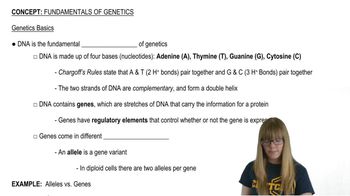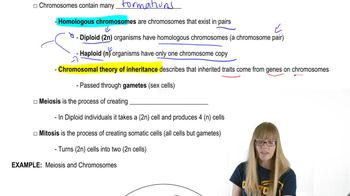Table of contents
- 1. Introduction to Genetics51m
- 2. Mendel's Laws of Inheritance3h 37m
- 3. Extensions to Mendelian Inheritance2h 41m
- 4. Genetic Mapping and Linkage2h 28m
- 5. Genetics of Bacteria and Viruses1h 21m
- 6. Chromosomal Variation1h 48m
- 7. DNA and Chromosome Structure56m
- 8. DNA Replication1h 10m
- 9. Mitosis and Meiosis1h 34m
- 10. Transcription1h 0m
- 11. Translation58m
- 12. Gene Regulation in Prokaryotes1h 19m
- 13. Gene Regulation in Eukaryotes44m
- 14. Genetic Control of Development44m
- 15. Genomes and Genomics1h 50m
- 16. Transposable Elements47m
- 17. Mutation, Repair, and Recombination1h 6m
- 18. Molecular Genetic Tools19m
- 19. Cancer Genetics29m
- 20. Quantitative Genetics1h 26m
- 21. Population Genetics50m
- 22. Evolutionary Genetics29m
1. Introduction to Genetics
Fundamentals of Genetics
Problem 10c
Textbook Question
Define each of the following terms:
genotype
 Verified step by step guidance
Verified step by step guidance1
Understand that 'genotype' refers to the genetic makeup of an organism, specifically the alleles present at a given set of loci.
Recognize that genotypes are often represented by letters, where each letter represents a different allele. For example, 'AA', 'Aa', or 'aa' could represent different genotypes for a single gene.
Consider that the genotype determines the potential traits (phenotype) an organism can express, but the environment can also influence the phenotype.
Remember that genotypes can be homozygous (two identical alleles, e.g., 'AA' or 'aa') or heterozygous (two different alleles, e.g., 'Aa').
Reflect on how genotypes are inherited from parents, with each parent contributing one allele to the offspring's genotype.
Recommended similar problem, with video answer:
 Verified Solution
Verified SolutionThis video solution was recommended by our tutors as helpful for the problem above
Video duration:
1mPlay a video:
Was this helpful?
Key Concepts
Here are the essential concepts you must grasp in order to answer the question correctly.
Genotype
The genotype refers to the genetic constitution of an organism, encompassing all the alleles inherited from its parents. It determines the potential traits that an organism can express, although not all genotypes are phenotypically visible. For example, an individual may carry alleles for a trait that are not expressed due to dominance or environmental factors.
Recommended video:
Guided course

Gamete Genotypes
Alleles
Alleles are different versions of a gene that can exist at a specific locus on a chromosome. Each individual inherits two alleles for each gene, one from each parent, which can be identical (homozygous) or different (heterozygous). The combination of these alleles contributes to the organism's genotype and can influence its phenotype.
Recommended video:
Guided course

New Alleles and Migration
Phenotype
The phenotype is the observable physical and physiological traits of an organism, which result from the interaction of its genotype with the environment. While the genotype provides the genetic blueprint, the phenotype reflects how these genes are expressed in a given environment. For instance, two plants with the same genotype may exhibit different heights if grown in varying soil conditions.
Recommended video:
Guided course

Mutations and Phenotypes

 8:55m
8:55mWatch next
Master Genetics Basics with a bite sized video explanation from Kylia Goodner
Start learning



